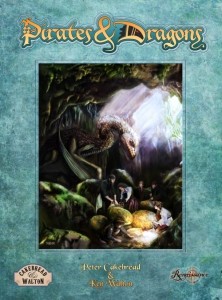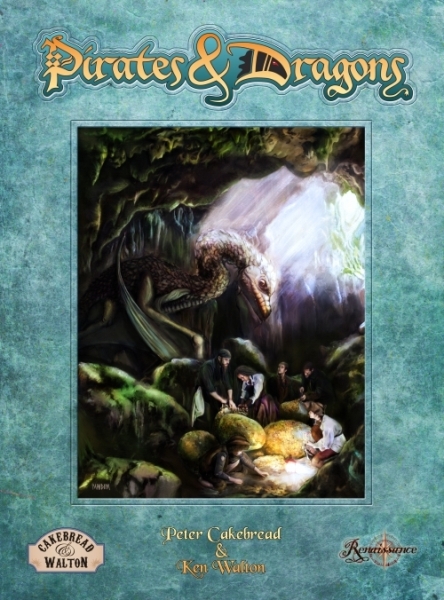
Pirates & Dragons
Pirates & Dragons is a complete pirate epic fantasy role-playing game, written by Ken Walton and Peter Cakebread and published by Cakebread & Walton.
By Aaron T. Huss

Learn more about Pirates & Dragons here
Purchase Pirates & Dragons here
Find other Renaissance posts here
Pirates & Dragons is the latest incarnation of the Renaissance system from Cakebread & Walton. Dubbed fantasy swashbuckling in a world of magic, the game has a very interesting blend of themes. Yes it has pirates, and yes it has dragons, but the depth of those two themes are possibly more than you realize until reading the book. Additionally, to support the depth of this blend of themes is a slightly new take on the Renaissance system with the exclusion of Factions, because they don’t apply, and the inclusion of Talents and Doubloons to amp-up the swashbuckling action. This is all wrapped around a unique setting featuring a sea filled with islands ready to be explored, exploited, plundered, and who knows what else! So even though this is a Renaissance-based RPG (or rather Renaissance compatible), it’s truly its own beast to create everything necessary to play in a world filled with pirates and dragons.
I will admit that I have one strong bias regarding Cakebread & Walton – they create interesting settings that blend vanilla themes to create something unique. I’m not much for vanilla, but throw in a little of this and a little of that and I’m there! However, after I read Pirates & Dragons, I have to disagree a bit with simply calling it fantasy swashbuckling in a world of magic. I think it goes much further than that. In fact, I see Pirates & Dragons as a blending of the Age of Sail, Renaissance England, and tribal fantasy. Take a world that has reached a level akin to Renaissance England, but it surrounds this very large sea that’s filled with islands. Pirate, privateer, and merchant activities cross this large sea all the time to support this world around it. However, dwelling on those islands are people cut from a much different cloth. They exist as tribes on dozens of islands that could be lorded over by a dragon, enslaved by a dragon, lorded over a civilization that uses the sea for merchant activities, or continuously raided by pirates. It’s a definite blending of technology levels, fully embracing the simple concept of pirates and dragons.
Why dragons? Because dragons are big, nasty, scary creatures that can be an ally, enemy, or horrific being. These tribal islanders have been living in this dragon-filled world for ages, but the world outside only seems to come into contact with them when they travel across the sea or attempt to plunder the dragon. Hey, that goes back to the original pirates and dragons theme! Of course, this is just the setting…
The Pirates & Dragons version of the Renaissance system is definitely modified to support the action and adventure on the high seas, tribal magic, black powder weapons, and those pesky dragons! How did they do this? With magic of course! Or three new major mechanics called Doubloons and Talents with the added mechanics for ships. Talents are like Heroic Abilities in Legend, but much easier to obtain and without quite the drastic in-game effect. This simple mechanic helps characters reproduce the high action and adventure theme that surrounds pirate and swashbuckling settings. Doubloons are those awesome in-game currency characters can use to swing the story in their favor or overcome a bad dice roll. This goes hand-in-hand with Talents to recreate that high action setting.
Adding to these two new mechanics is the reproduction of life on a ship. I’m not talking about just having a ship with stats, I’m referring to mechanics that embrace the ship AND the crew. Yes you get the standard ship templates and weapons, but you also get all the different crew responsibilities, naval combat, ship upgrades, ship-oriented skills, repair, and of course what to do when coming into contact with those pesky dragons. Man, they always seem to get in the way!
This is definitely an interesting setting with a set of mechanics that embraces the various aspects of the setting. In fact, without the changes made to the Renaissance system, Pirates & Dragons would feel flat and not swashbuckling fantasy at all.
